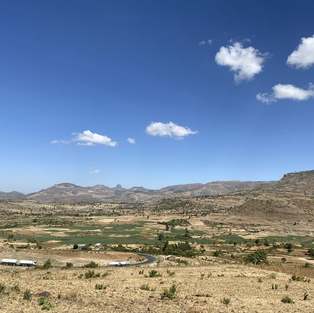Gondar groove
- Natalie Dimmock

- Jan 5, 2021
- 4 min read
Updated: Aug 18, 2021
On 4th January, we packed up and left the Winn Hotel in Bahir Dar for the long, but beautiful, drive to Gondar. There are various sites to see on the road to Gondar but we did the drive without stopping and it took around 3 hours to cover the 175km, leaving at about 9am and arriving around midday. I wasn't too worried about that as 3 hours in the car was probably Tiger's limit! Me and the driver, called, memorably "Ebay", spent most of the journey pointing out cows, donkeys, horses, trees, "babies" (kids), minibuses, trucks, buses and bajajs (tuk tuks). I am not sure I could have done longer than three hours with a toddler on my lap! The mountainous scenery was simply stunning.
We arrived at the AG Hotel and checked into our room which had the biggest bed ever! I had chosen it over the Inn of the Four Sisters which I think would have been a nicer place to stay, because it had bigger rooms and a bigger bathroom which Tiger slept in, where-as I don't think we could have managed that at the Four Sisters. Our total hotel bill came to 5443 Birr for two nights and one round of laundry (£100) so probably one of the most expensive stays, but perfectly comfortable. They also took credit cards which was a bit of a bonus as Ethiopia is so cash based and it's difficult pulling out enough cash from the ATMs. On our first night we went to the Inn of the Four Sisters for dinner and it was just amazing - delicious food, wine, great options for Tiger who worked her way through penne pasta with tomato. They were so welcoming and accommodating, the food was top notch, they took credit cards, and it was only a five minute walk from the AG Hotel. We slightly lost track of time on our first night and by the time it came to leave (6.45pm or so) it was dark and their security guard walked us back to our hotel. It was so lovely we went back the second night. I felt so sorry for them as we were the only dinner guests and they were so thankful to us for coming.
As I only really had one whole day in Gondar, 5th January, I asked at the front desk of the hotel for a guide the night before and they phoned a lovely local guide called Mulla. He quoted me $65 and I really didn't see the point in negotiating, although I am certain I could have gotten the price down a little. At the end of the day, the tourist trade is on its knees due to covid and I really don't mind putting that extra bit of money into the guides' and drivers pockets who have had precious little work in 2020. We were picked up in car with a driver and set off to see the main sites from 9am. I am generally not that "into" guides but I also felt that I learnt a lot more from having him, as so many things he pointed out I'd never have picked up on otherwise.
Gondar is the largest of the three former capitals that form the backbone of northern Ethiopia's historical circuit and stands at 2,200m in the highlands north of Lake Tana. The city was established in circa 1635 as the permanent capital of Emperor Fasilidas. Our first stop was to Fasil Ghebbi (Fasilida's Compound, also known as the Royal Enclosure), a walled compound enclosing half a dozen 17th century castles and palaces and a UNESCO World Heritage Site since 1979. Surrounded by tall mossy stone walls, the oval 7 hectare enclosure contains six stone castles and several smaller buildings. Tiger started on my back but was soon running around with Mulla and I chasing her meaning I think I took in about 50% of the information he told me! I found it quite fascinating seeing former banquet rooms, a water storage tank, hamman buildings, lion cages (!) and amazing views of churches from the castles in every direction. The Italians occupied Gondar from 1936-41 and developed the town into a major administrative centre housing up to 40,000 soldiers in the Royal Enclosure. In fact some of the buildings were converted to hold arms. The Royal Enclosure was also bombed by the British and it was at Gondar that the Italians made their last stand, surrendering to the allied army on 27 November 1941, following an offensive which claimed the lives of 206 British and Ethiopian soldiers.
We then drove over to Debre Berhan Selassie, a church consecrated in 1693, and particularly famous for its beautiful art which graces every corner of the ceiling and walls. The ceiling in particular has 80 cherubic faces (angels) in neat rows. The church now has 8 monks and we met one of them who kindly played with Tiger who was obsessed with sitting on every chair "Tiger's chair", and she also had a decent go at banging the drums.
We continued on by car to Fasilida's Bath, a 2,800m sunken bathing pool enclosed by a stone wall and six turrets, and overlooked by a two-storey building said to have been Fasilida's second residence. They have now started to fill the bathing pool with river water which looks like it will take some time (they have two weeks until 19th January and Timkat "Epiphany" when there will be a huge ceremony held here).
Just outside of the pool, we walked over to a six pillared pavilion built it as a mausoleum by Emperor Iyasu I for his father Yohannes I's favourite horse Suviel. Mulla and I were talking to Tiger about "horses" and she simply looked at us as if we were mad!
The tour ended with me having an Ethiopian coffee and Tiger having a bit of spicy rice. We were back for naptime where I powered through some work, and had dinner at the Four Sisters again.
















































































































Comments